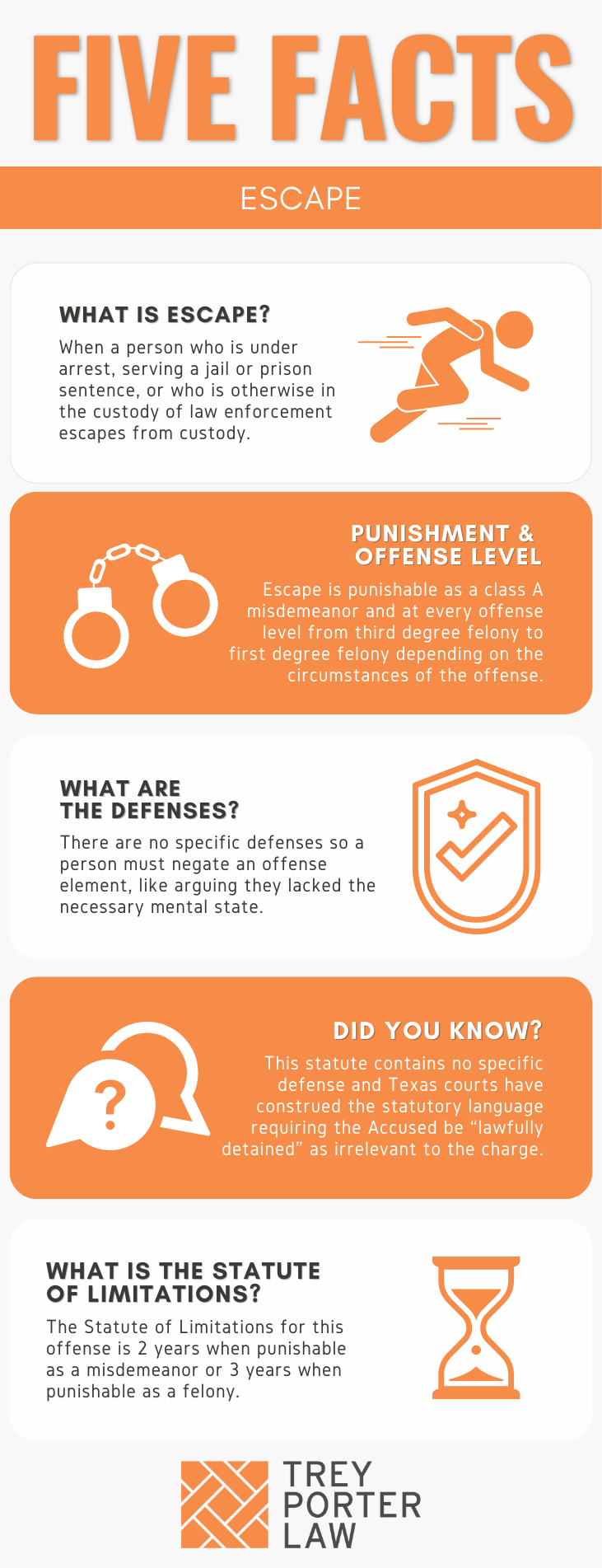WHAT IS ESCAPE IN TEXAS?
The Texas law against escape prohibits a person in custody who is charged with, convicted of, or detained or under arrest for an offense from moving outside the bounds of confinement without authority.

WHAT IS THE ESCAPE LAW IN TEXAS?
Tex. Penal Code § 38.06. ESCAPE.
(a) A person commits an offense if the person escapes from custody when the person is:
(1) under arrest for, lawfully detained for, charged with, or convicted of an offense;
(2) in custody pursuant to a lawful order of a court;
(3) detained in a secure detention facility, as that term is defined by Section 51.02, Family Code; or
(4) in the custody of a juvenile probation officer for violating an order imposed by the juvenile court under Section 52.01, Family Code.
(b) Except as provided in Subsections (c), (d), and (e), an offense under this section is a Class A misdemeanor.
(c) An offense under this section is a felony of the third degree if the actor:
(1) is under arrest for, charged with, or convicted of a felony;
(2) is confined or lawfully detained in a secure correctional facility or law enforcement facility; or
(3) is committed to or lawfully detained in a secure correctional facility, as defined by Section 51.02, Family Code, other than a halfway house, operated by or under contract with the Texas Juvenile Justice Department.
(d) An offense under this section is a felony of the second degree if the actor to effect his escape causes bodily injury.
(e) An offense under this section is a felony of the first degree if to effect his escape the actor:
(1) causes serious bodily injury; or
(2) uses or threatens to use a deadly weapon.
WHAT IS THE PENALTY CLASS FOR ESCAPE IN TEXAS?
The penalty classification for escape depends on the severity of the conduct, and the escapee’s status at the time of the offense. By default, escape from custody is a Class A misdemeanor, punishable by up to one year in county jail. The penalty category for escape is increased to a:
- Third degree felony, punishable by two to ten years in prison, if the person:
- escapes from a secure correctional facility; or
- escapes while arrested for or charged with a felony offense;
- Second degree felony, punishable by two to 20 years in prison, if the person:
- causes bodily injury during the escape;
- First degree felony, punishable by five to 99 years in prison, if the person:
- causes serious bodily injury during the escape; or
- uses or threatens to use a deadly weapon.
WHAT IS THE PUNISHMENT RANGE FOR ESCAPE IN TEXAS?
A person charged with escape may face a punishment range of up to one year in jail, or up to life in prison, depending on the person’s conduct.
- First degree felony (if the person causes serious bodily injury or uses or threatens to use a deadly weapon):
- five to 99 years or life in prison, maximum $10,000 fine;
- Second degree felony (if the person causes bodily injury):
- two to 20 years in prison, maximum $10,000 fine;
- Third degree felony (if the person escapes while under arrest for or charged with a felony, or escapes from a secure correctional facility):
- two to ten years in prison, maximum $10,000 fine;
- Class A misdemeanor:
- up to one year in jail; maximum $4,000 fine.
WHAT ARE THE PENALTIES FOR ESCAPE IN TEXAS?
A person charged with escape may be eligible for either probation after a conviction, or deferred adjudication without a conviction. The maximum term of community supervision for a first degree, second degree, or third degree felony escape is ten years. The period of community supervision for a Class A misdemeanor escape charge may not exceed two years.
WHAT ARE THE DEFENSES TO ESCAPE IN TEXAS?
The statute does not authorize specific defenses to escape. A person accused thereof may assert any of the justification defenses, or attempt to negate at least one of the elements the State must prove at trial.
- Can a person charged with escape argue it was necessary? Texas Penal Code Section 9.41, the necessity defense, is available in every case unless specifically excluded by law. Necessity may justify an escape.In Spakes v. State, a prisoner on trial for escaping jail argued his cellmate planned the escape, and threatened to cut his throat if he did not accompany him. The jury was entitled to decide whether he reasonably believed he needed to commit a crime to avoid being killed. If the jurors believed the defendant was faced with a specific threat of death, his escape from custody may have been justified.
- Can a person who was not in custody be charged with escape in Texas? A person must be in custody in order to be charged with escaping custody. While the statute permits charging a person with escaping custody if he was “lawfully detained for” any offense, courts continue to interpret the “custody” requirement as some restriction of a person’s liberty. See Warner v. State, 257 S.W.3d 243 (Tex. Crim. App. 2008). Alternatively, if the detention or arrest did not rise to the level of custody, a person may be charged with evading arrest or detention.
- Can a person be charged with escaping custody if the custody was illegal? Texas Penal Code Section 38.08 provides that it is “no defense to prosecution under Section 38.06 or 38.07 that the custody was unlawful.” However, the escape law also requires a person to be “lawfully detained.” Courts have resolved this apparent conflict by applying the “lawfully detained” language narrowly, and deem the lawfulness of a person’s arrest or incarceration irrelevant as a defense to escape. Ultimately, the law requires a person to submit to an arrest to maintain public order.
WHAT IS THE STATUTE OF LIMITATIONS FOR ESCAPE IN TEXAS?
The limitation period for escape categorized as a Class A misdemeanor is two years. If the escape is classified as a felony, the limitation period is three years.
ESCAPE IN TEXAS
In 2011, the Legislature expanded the application of the escape statute to those who were “lawfully detained for” a crime. Texas courts, however, continue to hold that escape can only occur after an officer has successfully restrained or restricted a suspect’s movement.
TEXAS ESCAPE COURT CASES
The case law regarding escape in Texas shows that, despite the Legislature’s 2011 amendment adding the “lawfully detained for” language, courts continue to require a restriction of a person’s liberty beyond an ordinary investigative detention to sustain an escape conviction.
- In Nix v. State, the defendant was reporting to his parole officer (“PO”), and had an active arrest warrant on an unrelated case. After finding out about the warrant, the PO tried to escort the defendant to the sheriff’s office. The PO told the defendant about the warrant as they were walking in, and the defendant backed away. The PO grabbed the defendant’s arm and told him he was in custody, but the defendant ran, and was convicted of escape.The appellate court reversed the conviction, holding the defendant was not in custody. He never submitted to a show of authority, nor was he ever successfully restricted or restrained.
















